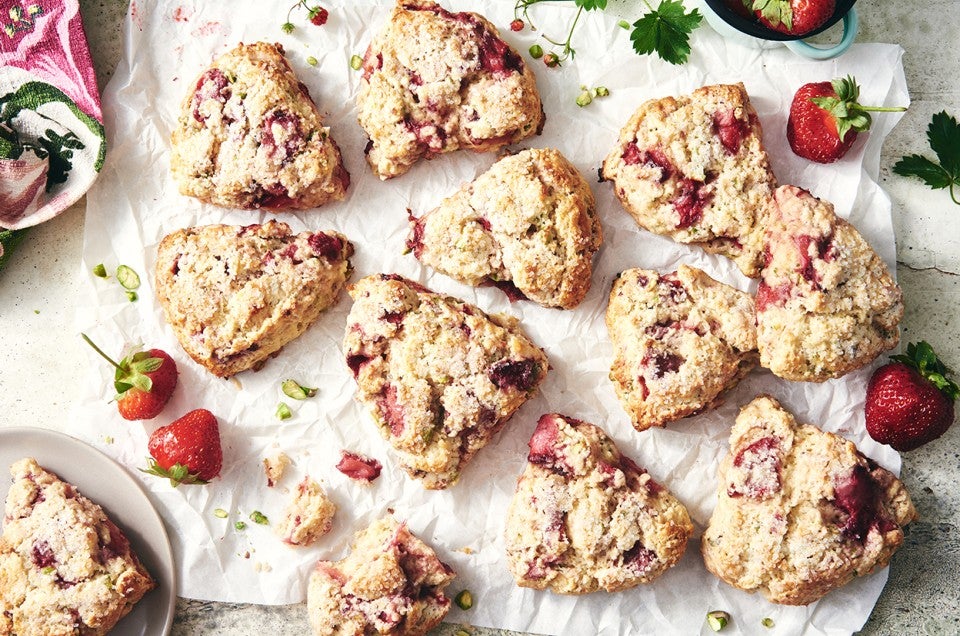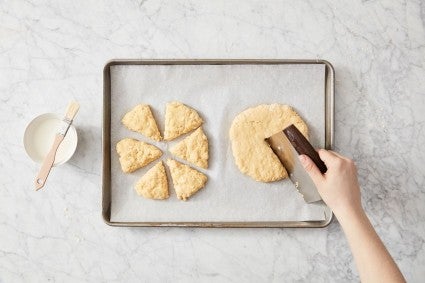


 The bakers of King Arthur are here to solve the kitchen conundrums you share with us, whether it’s on the phone, computer, or by the good old postal service. In Ask the Baker’s Hotline, Annabelle will pick the brains of the talented King Arthur Baker’s Hotline team to tackle some of your most-asked questions. Today’s query: how to make scones moist.
The bakers of King Arthur are here to solve the kitchen conundrums you share with us, whether it’s on the phone, computer, or by the good old postal service. In Ask the Baker’s Hotline, Annabelle will pick the brains of the talented King Arthur Baker’s Hotline team to tackle some of your most-asked questions. Today’s query: how to make scones moist.
* * *
When done right, scones are a delightful treat. But when they turn out dry, it feels like there isn’t enough butter, jam, or clotted cream in the world to right that wrong. Talk about a letdown. But fear not, because Bethany from our Baker’s Hotline is here to banish the dreaded dry scone with some expert tips and techniques.
Measure flour by weight: “Making moist scones begins with accurate flour measurement,” Bethany says. Flour measured by volume easily compacts, so you end up adding more than the recipe calls for. As a result, scones will be denser, drier, and crumblier than intended. For the most accurate results (and fewer dishes to wash), measure your flour by weight with a baking scale instead of measuring cups. “If you don’t have a scale, fluff the flour before sprinkling it into the measuring cup, then level it off without compacting it,” says Bethany. See more here: How (and why) to measure flour the right way.
Handle scone dough gently: “Overmixing leads to too much gluten development, which leads to tough, dense scones, instead of flaky, moist ones,” says Bethany. Once you’ve added the liquid in your recipe, mix the dough gently until just combined — and no more. “Aim for a slightly tacky dough that holds its shape when pressed,” Bethany advises. When it comes to shaping, avoid rolling, cutting, and rerolling the dough, which can overwork it. Instead, use a scone scoop or a scone pan, or press the dough into a circle with your fingers, then cut it into wedges with a bench knife.

Don’t overbake! If you bake scones too long, they’ll dry out, so keep an eye on them through the oven window. (Don’t open the oven to look — it’ll let out the heat.) “Bake your scones until they are just golden brown,” Bethany recommends. And for accurate baking, ensure your oven is running at the right temperature with an oven thermometer.
Use high-quality ingredients — and keep them cold: “Using fresh, high-quality butter and cream ensures a rich flavor and tender texture,” Bethany explains. Make sure your butter and liquid ingredients are cold, too. If the butter is soft when your scones enter the oven, it will leak out, taking your scone’s moisture with it. And don’t forget to use high-quality flour, which will give you consistent results, great flavor, and the structure needed for a good rise.
Once the basics are nailed down, there are even more ways to enhance the flavor, texture, and moisture level of your scones.
Add moisture-boosting mix-ins: “Adding fruit, Jammy Bits, or chocolate can introduce moisture and flavor to your scones,” Bethany says. “Don't be afraid to get creative. Experiment with different flavor combinations to customize your scones to your liking.” Whether you prefer classic flavors like blueberry-lemon or chocolate chip, or more unique combinations like Carrot Cake Scones or our bakery’s popular Bacon Cheddar Chive Scones, the possibilities are endless. (Note: Butter-based scones are sturdier and able to handle more mix-ins than cream-based scones.)
Freeze for more moisture and a better rise: Freeze your scones for about 30 minutes before baking to help them rise taller while maintaining moisture and flavor. “Since scones are one of those baked goods best enjoyed within a day or so of baking, freezing some of them, unbaked, for future enjoyment is a great way to bake moist scones at a moment’s notice,” Bethany recommends.

Add toppings: Once your scones are cooled, a quick glaze of confectioners’ sugar and milk (or tea!) will add a pretty coat of additional flavor and moisture. Take the decadent route and top your scones with frosting, like our Carrot Cake Scones with Cream Cheese Frosting. (Frosting makes everything better.) If you don’t want your topping to add sweetness, try brushing your scones with melted butter as soon as they come out of the oven. It will sink in through the crust and give them a moist, rich boost.
By focusing on precise flour measurements, gentle dough handling, great ingredients, and well-timed baking, you can create moist, tender scones every time. So go ahead, get baking! Choose cream-based scones for a super-tender, cakey scone (5/5 on the scone moisture scale), or make butter-based scones for a flakier, biscuit-like scone (4/5 on the scone moisture scale).
We have everything you need to make scrumptious scones, from pans to mixes to tools and more.
Cover photo (Roasted Strawberry and Pistachio Scones) and food styling by Liz Neily.

